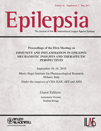Vaccinations and febrile seizures
Summary
The occurrence of seizures related to fever results from complex interactions among genetic and environmental factors. The issue of the relationship between vaccination and febrile seizures is complex. It is difficult to identify whether the febrile seizures result from a nonspecific fever caused by vaccination or if these are secondary to an encephalitis or encephalopathy caused by the vaccine. There is evidence showing that vaccination does trigger the onset of febrile seizures in one third of patients with Dravet syndrome. In general, febrile seizures that occur after vaccination do not seem to be different from febrile seizures from other causes, thus advances in knowledge about febrile seizures in general should be relevant to vaccine-associated febrile seizures.
The recent evidence pertaining to the relationship between febrile seizures (FS), childhood immunization, and vaccine encephalopathy will be discussed. FS are the most common type of seizures in childhood. Seizures following vaccination have for the most part been associated with a febrile episode. Differentiation of FS from acute symptomatic seizures secondary to central nervous system (CNS) infection or seizures triggered by fever in children with preexisting epilepsy is essential (Commission, 1989). The syndrome of FS is defined as seizures associated with fever in the absence of CNS infection or acute electrolyte imbalance in a young child. The prevalence of FS varies between 3% and 8% in children up to 7 years of age (Commission, 1989; Sadleir & Scheffer, 2007). Variation in prevalence relates to differences in case definitions, ascertainment methods, geographic variation, and cultural factors. Some series in the past did not exclude seizures precipitated by fever that may have been accompanied by an underlying neurologic disturbance such as meningitis, toxic encephalopathy, or encephalitis. Therefore, the prognosis of FS in the early literature was far more pessimistic than it is today (Shinnar et al. 2008). Another important issue is the relationship between FS and epilepsy later in life, particularly temporal lobe epilepsy (TLE). Although a number of retrospective studies have shown that complex FS may be a causative factor for the later development of TLE, prospective studies have shown that most children who had FS do not develop epilepsy later in life (Cendes, 2004; Sadleir & Scheffer, 2007). Most likely the association between FS and TLE results from complex interactions among several factors—both genetic and environmental (Sadleir & Scheffer, 2007). In that context, the issue of the relationship between vaccination and FS is complex. It is not easy to sort out whether the FS result from a nonspecific fever caused by vaccination or if these are secondary to an encephalitis or encephalopathy caused by the vaccine.
Vaccination and Epileptic Encephalopathy: Is There a Relationship? (I. E. Scheffer, Melbourne, Australia)
Recent observations and data about the relationships between vaccination and epileptic encephalopathy shed new light into a controversy not only involving the medical community, but also the public interest and legislation in several countries. This controversy surrounding the potentially devastating effects of vaccination have been rife for many years since the emergence of a disorder of so-called “vaccine encephalopathy,” where a previously well infant experienced sudden onset of seizures and encephalopathy soon after vaccination. This disorder has resulted in significant legal battles with large monetary payouts for individuals who had sustained the so-called “vaccine encephalopathy” in compensation for the alleged “damage” caused by vaccination. Concerns about vaccination are further championed by antivaccination lobby groups, resulting in compromised rates of vaccination with major public health consequences. A similar story is currently being played out in legal battles in the United States with regard to vaccination and autism spectrum disorders.
The entity of “vaccine encephalopathy” is poorly defined. No specific electroclinical features have been delineated, and the time of onset from vaccination has not been clearly specified. Nevertheless, large scale epidemiologic studies have failed to confirm an association between vaccination and encephalopathy. The pivotal study of Dr. Scheffer’s group reported on 96 patients with epileptic encephalopathies largely beginning in the first year of life, 14 having vaccine-related onset (Berkovic et al., 2006). Vaccine-related onset was defined as seizures beginning within 72 h of vaccination. Careful phenotyping of 14 cases of alleged “vaccine encephalopathy” (patients aged 2.5–47 years), revealed striking similarities with Dravet syndrome in 12 cases, and SCN1A mutations were identified in 11. The phenotype was consistent with classical Dravet syndrome in eight individuals (all with SCN1A mutations) and the borderline form of Dravet syndrome in four cases; the two remaining cases had Lennox-Gastaut syndrome.
More than 70% of patients with Dravet syndrome, a severe epilepsy syndrome that frequently begins with febrile status epilepticus, have mutations of the gene encoding the alpha-1 subunit of the neuronal sodium channel, SCN1A (Harkin et al., 2007). The hypothesis that patients with “vaccine encephalopathy” may have SCN1A mutations was tested in the cohort of 14 patients. Eleven patients had SCN1A mutations, including all eight with classical Dravet phenotype and three of four with the borderline Dravet phenotype. Therefore, these patients were destined to have Dravet syndrome and the vaccination was merely the first trigger at an age when seizures would typically begin in the patient’s life. FS are commonly the first manifestation of Dravet syndrome. Consequently, any febrile illness could have produced the first seizure in the genetically susceptible individuals, and the febrile response to immunization, although commonly encountered, would not have produced an epileptic encephalopathy in an individual without a mutation conferring genetic susceptibility. Interestingly the patients’ families argued that the vaccination was causative as there was no family history of seizure disorders. This observation was explained at a molecular level by the finding that the SCN1A mutation had arisen de novo in the 9 patients for whom both parents’ DNA was available. Therefore, a significant proportion of patients with “vaccine encephalopathy” have Dravet syndrome with SCN1A mutations. At most, the vaccine may trigger seizure onset in an infant destined to have an epileptic encephalopathy.
From the perspective of Dravet syndrome itself, is there any truth to the long-held claim that vaccination is a precipitating factor? This association has been observed both by parents and clinicians. A cohort of patients with Dravet syndrome and SCN1A mutations was assembled on whom source data was available documenting the date of vaccination from the “baby book” of the patient and the date of seizure onset from hospital records. Of 40 patients, 12 had “vaccine-proximate” seizure onset defined as within 2 days of vaccination and 25 had “vaccine-distant” onset >2 days after vaccination; 3 had onset prior to vaccination. Detailed analysis of the phenotypes within each subgroup showed that the only significant difference was earlier onset of seizures in the vaccine-proximate group at 18.4 weeks compared with 26.2 weeks in the vaccine-distant group. In other aspects such as the features of the first seizure (fever, hemiclonic or bilateral seizure, status epilepticus), other seizure types, developmental regression, degree of intellectual disability, and nature of SCN1A mutation, no differences were found (McIntosh et al., 2010).
Thus vaccination does trigger the onset of seizures in one third of patients with Dravet syndrome. Some patients do not have a fever suggesting that fever per se is not the mechanism responsible for triggering seizures, rather another mechanism underlies seizure onset and may be a stress response to vaccination.
Future directions
Further research is required to understand the pathophysiology of this association. Since gross withholding of pertussis vaccinations might be dramatically unjustified and wrong, a strategy of how to best identify children at risk (by carefully taking the family history, establishing the family pedigree, and targeted genetic testing?) would be especially helpful.
Vaccines and Seizures: The Epidemiologic View (F. DeStefano, Atlanta, GA, U.S.A.)
One of the first and largest epidemiologic studies of seizures associated with vaccination was from the U.S. National Collaborative Perinatal Project (NCPP), which was conducted from 1959 to 1966 and enrolled 54,000 infants who were followed until age 7 years (Hirtz et al., 1983). Thirty-nine children had a seizure (39 of these were FS) within 2 weeks of immunization, and diptheria, tetanus, and pertussis (DTP) vaccine and measles vaccines were the most frequently associated vaccines. Whole-cell DTP and measles-containing vaccines have subsequently been the childhood vaccines for which an association with FS has been the most well established.
Two large studies in the United Kingdom and the United States have established an increased risk of febrile seizures following DTP vaccination; both have found that DTP vaccination results in 6–9 additional cases of FS per 100,000 vaccine doses (Farrington et al., 1995; Barlow et al., 2001). The whole-cell DTP vaccine is highly reactogenic, resulting in fever in up to 50% of vaccinated infants. A less reactogenic diptheria, tetanus, and acellular pertussis (DTaP) vaccine has been developed and is currently used in most developed countries. DTaP does not increase the risk of seizures, including FS (Huang et al., 2010).
At least three large epidemiologic studies have found that measles, mumps, and rubella (MMR) vaccine increases the risk of seizures in general or FS specifically (Farrington et al., 1995; Barlow et al., 2001; Vestergaard et al., 2004). Two studies were based primarily (Barlow et al., 2001) or exclusively (Farrington et al., 1995) on hospitalized cases, and both found that MMR vaccination resulted in 3–4 additional cases of seizure or FS per 10,000 doses of vaccine. A Danish birth cohort study of more than half a million children also found an increased risk (Vestergaard et al., 2004), but the number of additional cases of seizure attributable to MMR vaccination was estimated to be 16 per 100,000, which may be related to the inclusion of outpatient cases in the Danish study.
Combining varicella antigens in the same vaccine containing measles, mumps, and rubella antigens to create a combined MMRV vaccine has been found to increase the risk of seizure twofold above the risk of giving MMR and varicella vaccines at the same time but as separate injections (Jacobsen et al., 2009; Klein et al., 2010). MMRV vaccine has about seven times more varicella antigen content than does varicella vaccine. MMRV, however, induces a similar antibody titer to varicella but a higher titer to measles, as does giving MMR and varicella as separate vaccines, suggesting higher levels of measles vaccine virus replication.
In addition to DTP and measles-containing vaccines, other vaccines that may cause fever can also cause FS. An influenza vaccine has recently been implicated as causing FS. In April 2010, an influenza vaccine manufactured in Australia was found to be associated with an increased risk of FS in children <5 years of age, leading to recommendations not to use this vaccine in children.
Future directions
There is a need to better understand the biologic mechanisms related to pyrogenicity of specific vaccines and its relationship with FS. Further research on biologic mechanisms and risk factors for FS in general should have relevance for vaccine-associated FS.
Additional Contributors
F. De Stefano, Atlanta, GA, U.S.A.; I. Scheffer, Melbourne, Australia.
Disclosure
The authors have no conflicts of interest to declare. We confirm that we have read the Journal’s position on issues involved in ethical publication and affirm that this report is consistent with those guidelines.




